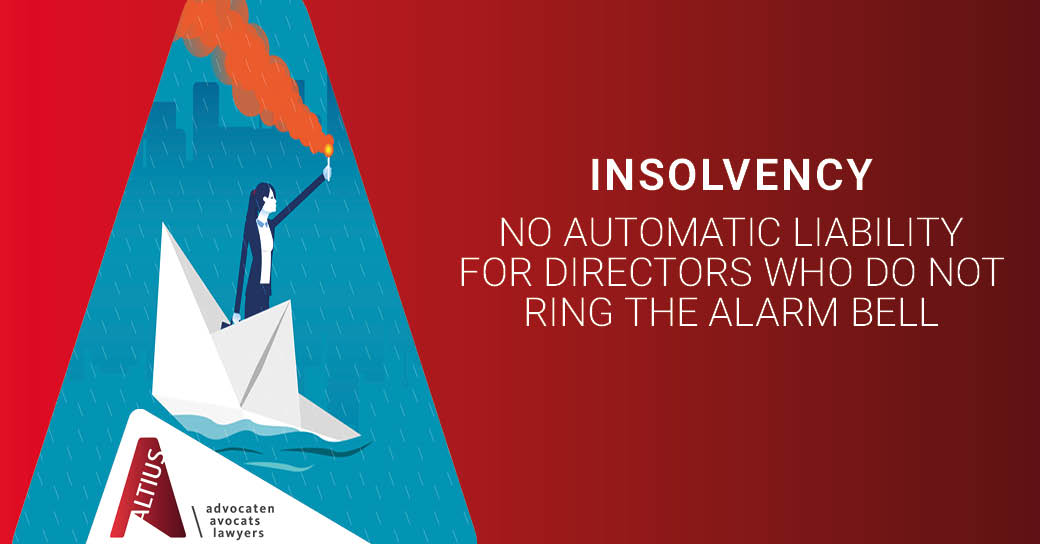New measures to address over-indebtedness and protect companies in difficulty

On 1 July 2024, the Act of 15 May 2024 on measures to address over-indebtedness and protect companies in difficulty (the “Act”) was published in the Belgian Official State Gazette.
The main amendments of the Act, as well as its entry into force, are briefly discussed below.
- Early debt detection for individuals
The Act’s main idea is for individuals who already have financial difficulties to avoid being needlessly confronted with legal proceedings and the associated legal costs and also possibly the bailiff’s enforcement costs. Claims that cannot be collected because of temporary or structural financial difficulties, should be detected as early as possible and, if a debt mediator has already been appointed, then he or she should be addressed. Within a month, the debt mediator should indicate whether the debt can be included in a repayment plan and, if appropriate, make an precise proposal for its inclusion. If the bailiff does not receive a response within the indicted period or if no repayment plan can be agreed, the bailiff may continue the recovery proceedings.
The Central file of notices of attachment, delegation, transfer, collective debt settlement and protest (“CCB“) is a database that could be used more efficiently to detect financial problems earlier. Therefore, the Act provides for the expansion of information in the CCB to include the bailiff’s site visit reports as well as a notice of amicable debt mediation. The report of the bailiff results from a site visit to the debtor’s home, following (for example) the service of a deed (summons, demand for payment, etc.). The inclusion of a notice of amicable debt mediation in the CCB makes it possible to promote amicable solutions, and informs the bailiff that the debtor is already on a path to reduce his/her debts.
- Measures to protect companies in difficulty
Information relating to a judicial reorganisation, bankruptcy procedure or transfer under judicial authority will now also be electronically accessible in the CCB. At present, bailiffs have to look up this information in the Belgian Official State Gazette.
Finally, the CCB is also extended to include a “control imminent insolvency” notification filed by the bailiff if he/she observes a situation that might indicate that the company’s continuity would be threatened immediately or in the long term. The Commercial Court’s Chamber of Companies in Difficulty (the “Chamber“) will be automatically notified.
The Chamber has to monitor a large number of companies based on the economic warning signals and the legislator considers it important that an informed selection can be made of the most urgent cases. The “control imminent insolvency” notification should contribute to this advance warning, as bailiffs already have a lot of information about a company’s situation (including through platforms such as Graydon and Companyweb).
On this basis, the bailiffs can then make an assessment, which can guide the selection to be made by the Chamber of files requiring further investigation.
As a result, it seems possible that, if a bailiff established during a formal notification or attachment, that the company in question does not have any assets or activities at the address of its registered seat, a notification in that regarding will be made by the bailiff in the CCB. This could then result into further steps by the Chamber.
Consequently, we expect Belgian “mailbox” entities of foreign companies to be summoned even faster in front of the Chamber. Such companies should be careful as notifications to appear in front of the Chamber are (only) sent (twice and) by regular mail. Not appearing in front of the Chamber can result into the (ex officio) opening of liquidation proceedings against the company in question by the President of the Commercial Court.
- Common attachment and attachment by comparison and extension
In the context of an enforcement procedure aimed at the recovery of a sum of money, it might happen that, regarding the same debtor, several attachment orders follow one another. To avoid useless costs and the succession of inventories of assets by several bailiffs, the legislator introduced two enforcement procedures
Either the creditor proceeds to an attachment by comparison and extension (Article 1524, paragraph 2 of the Judicial Code). The creditor then decides to compare the movables and objects on the list of attached goods and by extension, to attach the omitted goods. If the sale does not take place on the set date, the attaching creditor may have the sale conducted through the bailiff whom he has appointed for that purpose.
Or the creditor proceeds with a common attachment (Article 1524, paragraph 3 of the Judicial Code) if he is in possession of an attachment order that was rendered less than 3 years ago, that has not been lifted and has not been challenged in court. In this case, he decides to pursue the enforcement of his title on the basis of this attachment.
Since these procedures involve several inconveniences and are therefore not regularly used, the Act provides for some measures to optimise and digitise the communication between the bailiffs and make these procedures more readable and easier to use. Such modifications will enable the bailiff to advise the creditor as good as possible about the most appropriate type of enforcement measure or inform him/her of the debtor’s risk of insolvency.
- Miscellaneous provisions
A number of specific measures have also been taken to address over-indebtedness more effectively. For instance, bailiffs must undergo mandatory training in communication and facilitation skills.
The Act also provides that, in principle, the bailiff should refuse the sale of attached goods when he/she considers that the value of the attached goods is clearly insufficient to cover the cost of that sale.
Yet another measure allows the court, in derogation from Article 2223 old Civil Code, to apply the limitation period ex officio in recovery proceedings filed by companies against consumers.
- Entry into force of the Act
The Act’s entry into force will occur on different dates.
The articles relating to new announcements will enter into force on 1 July 2025, unless the King stipulates an earlier entry into force.
The articles on the derogation from the prohibition for the court to apply the limitation period ex officio, and the simplification and digitalisation of certain procedures will enter into force on 1 October 2024.
The article on training for bailiffs will enter into force on 1 January 2025.
If you have any questions or would like any further information, please contact Bart Heynickx or Roel Verheyden.
Written by
Recommended articles
New insolvency landscape on the horizon: more options for companies to reorganise and restructure
Belgium had accumulated a significant legislative backlog within insolvency law. The European Directive 2019/1023 on restructuring had to be transposed into national law by the member states by 17 July 2022 at the latest. The Belgian government did not submit a draft bill to this effect until 20 March 2023. This draft has since been voted into law and will enter into force on 1 September 2023.
Read onHeiploeg’s impact on Belgian insolvency law
The European Court of Justice’s (“ECJ”) Plessers judgment seemed to cause a serious threat for the applicability of the Belgian reorganisation procedure by transfer under judicial supervision, and the right of the interested buyer of the debtor’s activities to choose which particular employees it would take over. But, in the end, it has turned out to be “much ado about nothing”.
Read onNo automatic liability for directors who do not ring the alarm bell
On 16 September 2021, the Antwerp Court of Appeal ruled on the liability of the directors of a company that did not respect the so-called ‘alarm bell procedure’.
Read on



